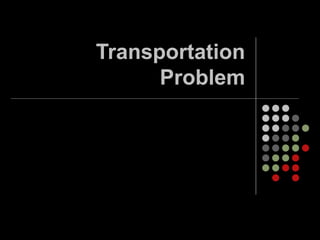
3Transportation_Problem.ppt
- 2. Introduction The transportation algorithm is applied to minimize the total cost of transporting a homogeneous commodity (product) from supply centers to Demand centers. It can also be applied to the maximization of some total value or utility. For e.g., Financial resources are distributed in such a way that the profitable return is maximized.
- 3. The Objective is to determine the number of units of an item which is to be supplied from the origin to a destination in order to satisfy the required quantity of goods or services at each destination centre, within the limited quantity of goods or services available at each supply centre, at a minimum transportation cost &/or time.
- 4. Mathematical Model Formulation Sources of supply are production facilities, warehouses or supply points, characterized by available capacities. The Destination are consumption facilities, warehouse or demand points, characterized by required level of demands.
- 5. The Transportation algorithm STEP 1 Formulate the problem & arrange the data in matrix form. STEP 2 Obtain an initial basic feasible solution. Different methods used : a. North West Corner Method b. Least Cost Method c. Vogel’s Approximation (or penalty) Method.
- 6. Initial solution obtained must satisfy the following conditions: A. Rim Condition - SUPPLY= DEMAND B. Allocations must be equal to m+n-1 If solution satisfies above condition is called Non- degenerate basic feasible solution otherwise degenerate solution.
- 7. STEP 3 Test the initial solution for optimality. To test optimality of the solution obtained in step 2 Modified Distribution (MODI) method is used. If the current solution is optimal, then stop, otherwise, determine new improved solution. STEP 4 Updating the solution Repeat step 3 until an optimal solution is obtained.
- 8. Vogel’s approximation method (VAM) VA (penalty or regret) method is a heuristic method & is preferred to the other two methods. In this each allocation is made on the basis of the opportunity (penalty or extra) cost that would have been incurred if allocations in certain cells with minimum unit transportation cost were missed. In this method allocations are made so that the penalty cost is minimized. The advantage of this method is that it gives an initial sol which is nearer to an optimal sol or is the optimal sol itself.
- 9. Example A company has 3 production facilites S1,S2,& S3 with production capacity of 7, 9, & 18 units (in 100s) per week of the product, respectively. These units are to be shipped to 4 warehouses D1,D2,D3 & D4 with requirements 5,8,7,14units in (100s) per week respectively. The transportation costs (in rupees) per unit between factories & warehouses are given in table:
- 10. D1 D2 D3 D4 Capacity S1 19 30 50 10 7 S2 70 30 40 60 9 S3 40 8 70 20 18 Demand 5 8 7 14 34
- 11. MODI Method 1. Check initial basic feasible solution using 1st three methods & put allocations. 2. Use economic interpretation Ui & Vj 3. To start with any one of u’s or v’s is assigned the value zero. Better to assign 0 where there are maximum no of allocations in a row or column 4. For occupied cell : Cij = Ui + Vj 5. For unoccupied cell : Dij = Cij – (Ui + Vj)
- 12. 6. Examin sign of each Dij: Dij >0 then current basic feasible sol is optimal Dij = 0 then current basic feasible sol will reamin unaffected but alternative sol exits. If one or more Dij < 0 then an improved sol can be obtained by entreing unocupied cell (I, j) in the basis. An unoccupied cell having the largest negative value of Dij is chosen for entering into the solution mix.
- 13. 7. Construct closed path (or loop) for the unoccupied largest negative oppurtunity cost 8. Assign + & - in loop. 9. Select smallest quality among loop (x= smallest value) 10. Optain new improved solution by allocating units to the unoccupied cell according to step 9 & calculate new transportation cost. 11. Test the revised sol further for optimality. The procedure terminates when all Dij > or = 0 for unoccupied cells.
- 14. D1 D2 D3 D4 Capacity S1 21 16 15 3 11 S2 17 18 14 23 13 S3 32 27 18 41 19 Demand 6 10 12 15
- 15. D1 D2 D3 D4 Capacity S1 1 2 1 4 30 S2 3 3 2 1 50 S3 4 2 5 9 20 Demand 20 40 30 10